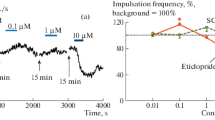Summary
Glutamate (50 mM) and aspartate (50 mM) applied intracochlearly increase the spontaneous activity of ganglion cells of the auditory nerve. This activity may account for the decreased magnitude of the compound action potential observed with these substances in previous studies, and also may be additional evidence that these substances have a role in synaptic transmission between the hair cells and primary auditory afferent nerve cells.
Similar content being viewed by others
References
Bobbin, R.P., Thompson, M.H.: Effects of putative transmitters on afferent cochlear transmission. Ann. Otol. Rhinol. Laryngol. 87, 185–190 (1978)
Edwards, A.L.: Experimental design in psychological research. New York: Holt, Rinehart and Winston 1964 (Revised edition)
Godfrey, D.A., Carter, J.A., Berger, S.J., Matschinsky, F.M.: Levels of putative transmitter amino acids in the guinea pig cochlea. J. Histochem. Cytochem. 24, 468–470 (1976)
Guth, P.S., Norris, C.H., Bobbin, R.P.: The pharmacology of transmission in the peripheral auditory system. Pharmacol. Rev. 28, 95–125 (1976)
Katsuki, Y.: The ionic receptive mechanism in acoustico-lateralis system. In: Basic Mechanisms in Hearing (eds. A.R. Moller, P. Boston), pp. 307–334. New York: Academic Press, Inc. 1973
Klinke, R., Evans, E.F.: Evidence that catecholamines are not the afferent transmitter in the cochlea. Exp. Brain Res. 28, 315–324 (1977)
Klinke, R., Galley, N.: Efferent innervation of vestibular and auditory receptors. Physiol. Rev. 54, 316–357 (1974)
Klinke, R., Oertel, W.: Amino acids-putative afferent transmitter in the cochlea? Exp. Brain Res. 30, 145–148 (1977a)
Klinke, R., Oertel, W.: Evidence that 5-HT is not the afferent transmitter in the cochlea. Exp. Brain Res. 30, 141–143 (1977b)
Klinke, R., Oertel, W.: Evidence that GABA is not the afferent transmitter in the cochlea. Exp. Brain Res. 28, 311–314 (1977c)
Sewell, W.F., Guth, P.S.: Detection of the primary afferent auditory transmitter using biological assay. Soc. Neurosci. (Abst.) 3, 11 (1977)
Steinbach, A.B., Bennett, M.V.L.: Effect of divalent ions and drugs on synaptic transmission in phasic electroreceptors in a mormyrid fish. J. Gen. Physiol. 58, 580–598 (1971)
Author information
Authors and Affiliations
Rights and permissions
About this article
Cite this article
Bobbin, R.P. Glutamate and aspartate mimic the afferent transmitter in the cochlea. Exp Brain Res 34, 389–393 (1979). https://doi.org/10.1007/BF00235683
Received:
Issue Date:
DOI: https://doi.org/10.1007/BF00235683




